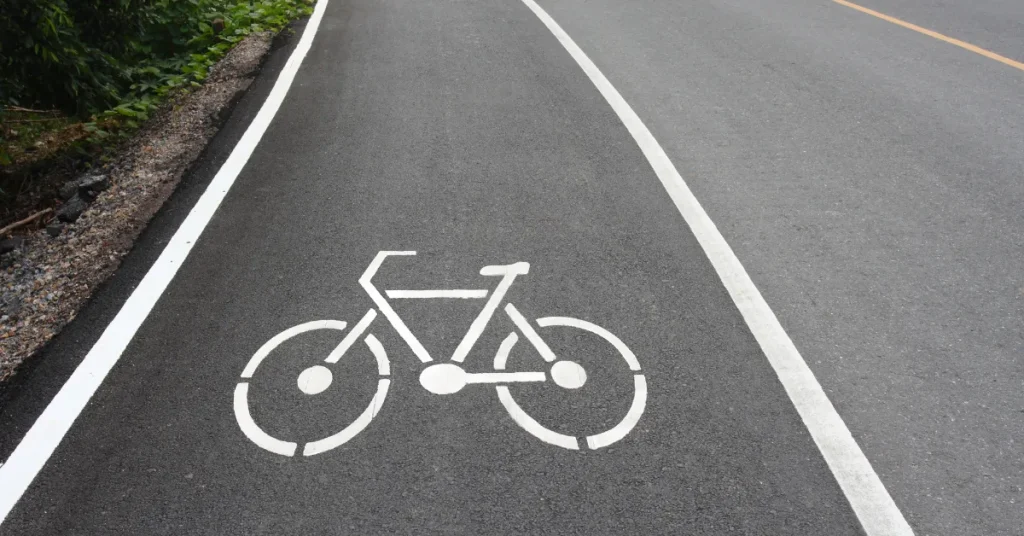A standard bike lane is typically 5 feet wide. The width can vary depending on local regulations and road constraints.
Navigating city streets by bike becomes safer and more efficient with designated bike lanes. These dedicated paths are engineered to accommodate cyclists alongside motorized traffic, promoting a seamless flow and reducing incidents.
The width of a bike lane plays a critical role in ensuring riders have adequate space to travel without interference.
Urban planners aim for a balance that respects both the needs of cyclists and the space available on existing roadways.
As cycling infrastructure becomes a priority in urban development, the presence of bike lanes signals a city’s commitment to sustainable and diverse transportation options.
Knowledge of bike lane standards is essential for cyclists and city planners alike, as it supports the design of safe and accessible urban environments.

The Basics Of Bike Lane Dimensions
The Basics of Bike Lane Dimensions are crucial for cyclist safety and city planning. Understanding how wide a bike lane should be sets the foundation for smoother, more efficient cycling paths.
Let’s dive into the standard measurements that dictate the size of these lanes and explore the variations from place to place.
Standard Width Measurements
Bike lanes come in various sizes, but they follow a common standard. Here’s what you need to know about their width:
- Minimum width: Typically, bike lanes are at least 1.5 meters (5 feet) wide.
- Ideal width: For enhanced safety, 1.8 to 2.5 meters (6 to 8 feet) is preferable, especially for high-traffic areas.
- Buffered lanes: These include a separation space, adding 2 to 3 feet to the overall width.
Bold, clear markings help signify these dimensions and guide cyclists appropriately.
Variations By Country And City
Bike lane widths can differ based on regional practices and traffic levels. Let’s look at these differences:
| Country/City | Typical Bike Lane Width |
| Amsterdam, Netherlands | 2.5 meters (8.2 feet) |
| Portland, USA | 2.44 meters (8 feet) |
| Copenhagen, Denmark | 2.2 meters (7.2 feet) |
| London, UK | Minimum of 1.5 meters (5 feet) |
These standards reflect a balance between urban space and the safety for cyclists.
Design Features That Influence Bike Lane Width
Planning a bike lane is a bit like tailoring a suit. It needs the right fit. Many factors decide how wide it should be. Let’s pedal through the design features that set the width of a bike lane.
Road Conditions And Infrastructure
Road features shape the bike lane’s size. Here’s why:
- Street Width: Wider roads allow broader lanes.
- Curbside Activities: Parking and bus stops need extra space.
- Intersections: These junctions often need wider lanes for safety.
- Drainage: Gutter slopes impact lane placement.
A table can clarify the adjustments for road elements:
| Road Feature | Ideal Width Increase |
| Parking | 3 feet |
| Bus Stops | 4 feet |
| Intersections | 2 feet |
| Drainage | 1 foot |
Bike Traffic Volume Considerations
Bike lane width must handle usage levels. Busier lanes are wider. Here’s how volume impacts design:
- Low: For few riders, lanes can be narrower.
- Medium: More riders need more width for comfort.
- High: Lots of bikes mean lanes must be widest.
We can visualize this with examples:
- Low Traffic: 5 feet is usually enough.
- Medium Traffic: Aim for 6 feet if possible.
- High Traffic: Go for 7 feet or more for easy passing.
Remember, a well-designed bike lane is safe and comfy for everyone cycling!
Regulatory Standards For Bike Lane Safety
- Ensuring cyclist safety demands stringent rules.
- These rules define bike lane width.
- They vary by location.
- Wider lanes generally mean safer rides.
- Standards are set by governments and international bodies.
- They guard against accidents.
- They provide a clear path for bike travel.
Government Guidelines And Policies
Different countries have different rules.
The USA uses the Manual on Uniform Traffic Control Devices (MUTCD).
- Standard width: 5 feet (1.52 meters) beside parking, 4 feet (1.22 meters) without it.
- Varies with traffic volume and speed.
- Adequate space is a must for cyclist safety.
International Safety Protocols
International agreements enhance safety.
They promote uniformity.
| Organization | Minimum Width |
| CROW (Netherlands) | 2.5 meters (8.2 feet) |
| Transport for London (UK) | 2.0 meters (6.6 feet) |
These entities set global benchmarks for design.
They focus on protecting cyclists everywhere.
The Impact Of Bike Lane Width On Cyclist Safety

The width of a bike lane plays a vital role in cyclist safety. A wide enough lane can offer cyclists plenty of space to maneuver. It helps avoid unexpected hazards. Cyclists feel safer when they have a designated and adequate space.
Let’s examine how lane width correlates with accidents. We will see the importance of visibility and space.
Case Studies: Accidents Vs. Lane Width
Analyzing case studies provides insight into the relationship between bike lane width and safety. Data collection from cities with varying lane widths has been crucial. Here are key findings from these studies:
- Narrow lanes often contribute to more accidents.
- Accidents decline as lanes increase in width.
- Wide lanes encourage more people to bike safely.
| City | Lane Width (feet) | Accidents per Year |
| City A | 3 | 50 |
| City B | 4 | 35 |
| City C | 5 | 20 |
The table shows that City C, with the widest bike lanes, has the fewest accidents. This emphasizes the benefits of wider bike lanes.
The Role Of Visibility And Space
Visibility and space are essential for cyclist protection. Here’s why:
- Better visibility reduces risks.
- More space helps cyclists steer clear of doors and debris.
- Visibility and space give confidence to riders.
A broader lane enhances visibility. Cyclists can maintain a safe distance from parked cars. Drivers can spot cyclists more easily. Thus, wide lanes make the roads safer for everyone.
A balanced bike lane design that considers both width and visibility will greatly improve cyclist safety. Such design efforts encourage active transport and healthier cities.
Best Practices For Planning And Creating Bike Lanes
Planning and creating bike lanes is crucial for safer, more efficient city travel. Cities must balance safety, space, and accessibility. Best practices include community input and cutting-edge engineering.
Community Involvement In Bike Lane Design
Listening to locals shapes successful bike lanes. Here’s how to involve them:
- Surveys and Forums: Gather feedback on bike lane locations and features.
- Public Meetings: Discuss plans and address concerns.
- Collaborative Mapping: Let locals suggest routes with interactive maps.
Future Trends In Bike Lane Engineering
Innovative bike lane designs point to a greener future. Upcoming trends include:
- Smart lanes: Sensors and LEDs improve safety.
- Green Waves: Timed lights for smooth bike flow.
- Solar Roads: Paths that generate clean energy.
Cyclist Advocacy And The Fight For Wider Bike Lanes

Safe cycling depends on bike lane width. Larger lanes mean safer roads. Cyclist advocacy plays a key role. They push for wider lanes. This helps everyone. Let’s explore their efforts and how cyclists can push for change.
Safe cycling is crucial. It needs proper infrastructure. Wider bike lanes are important. They offer more room to navigate. They also keep cyclists away from traffic.
Many cyclist groups fight for wider lanes. They understand safety’s importance. Advocacy efforts lead to real changes. Below are some success stories.
Case Examples Of Advocacy Success Stories
Cyclist groups work hard for better lanes. They meet with city planners. They work with engineers. Success stories inspire others. See some examples below:
- New York: Advocates pushed for protected lanes. Now, there are miles of safe lanes.
- Portland: Community efforts doubled lane widths. This made cycling much safer.
- Amsterdam: Advocacy led to a city-wide bike network. It’s a model for the world.
How Cyclists Can Get Involved And Push For Change
Anyone can advocate for wider lanes. Here are ways to get involved:
- Join local groups: They organize and plan. Together, voices are stronger.
- Attend meetings: City meetings shape roads. Your presence makes a difference.
- Speak out: Talk to neighbors and friends. Raise awareness about lane safety.
Email city officials, too. Write letters. Sign petitions. These actions push for wider bike lanes. Your involvement can lead to safer cycling for all.
FAQs About How Wide Is A Bike Lane
How Wide Is A Bicycle Lane?
A standard bicycle lane is typically between 4 to 5 feet wide. This allows enough space for cyclists to ride safely.
What Is The Typical Width Of A Cycle Lane?
The typical width of a cycle lane ranges from 1. 5 to 2 meters.
What Is The Best Width For A Bike Lane?
The optimal width for a bike lane is 5 feet (1. 5 meters) when adjacent to parking and 4 feet (1. 2 meters) without parking. This ensures safe passage for cyclists.
How Wide Are Protected Bike Lanes?
Protected bike lanes typically range from 4 to 5 feet wide, not including the buffer zone or barrier width. The width may vary based on local regulations and road conditions.
Conclusion
Navigating bike lane dimensions is crucial for city planners, cyclists, and motorists alike. Standard widths ensure safety and efficiency for all road users. As we’ve explored, the typical bike lane width can vary, but it remains a cornerstone of urban design.
Embracing this knowledge can lead to more harmonious and safer streets. Keep pedaling towards a well-informed, cycle-friendly world.
Resources:
1. https://highways.dot.gov/safety/pedestrian-bicyclist/safety-tools/pg-1-26-urban-bikeway-design-guide
